You are here
How to Make Kim Chi
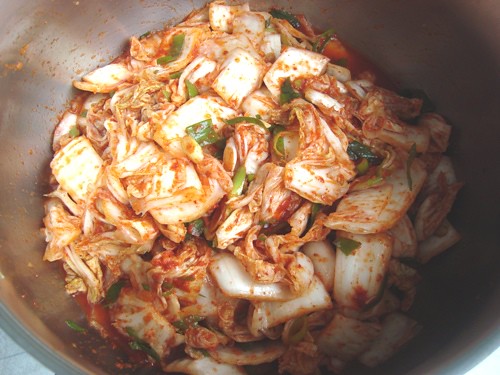
Originally posted in September of 2009
Of the countless varieties of kim chi that are made in Korea, by far the most common and celebrated version is made with Napa cabbage.
Kim chi that's made with cabbage is loaded with indole-3-carbinol (I3C), a compound that is well recognized as a powerful cancer-fighting compound. Numerous studies indicate that I3C can offer protection against many different types of cancer and may even stop the growth of existing tumors.
You could hop on over to a local Korean market to buy a bottle of kim chi, but it may not be as healthy as you'd like, since most commercially prepared varieties are made with white sugar and shrimp.
To make healthy kim chi that still has lots of flavor and health-promoting compounds, start with a whole head of fresh Napa cabbage:
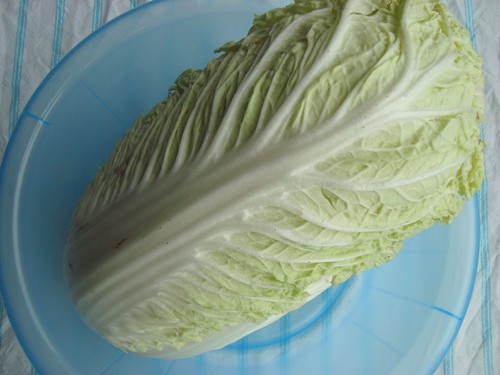
Separate the leaves and chop them up into bite-size pieces. These shreds of cabbage will shrink about 25% during processing, so no need to make them too small. And no need to clean them yet, as we'll be giving them a good rinse in a bit.
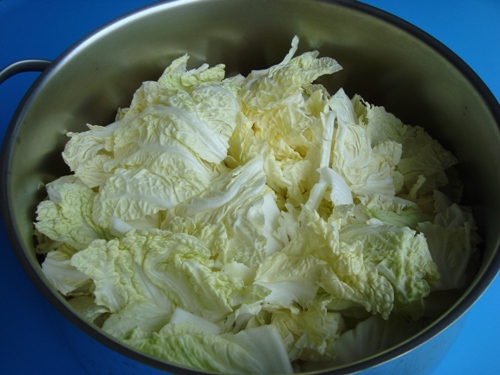
Measure out a quarter cup of sea salt.
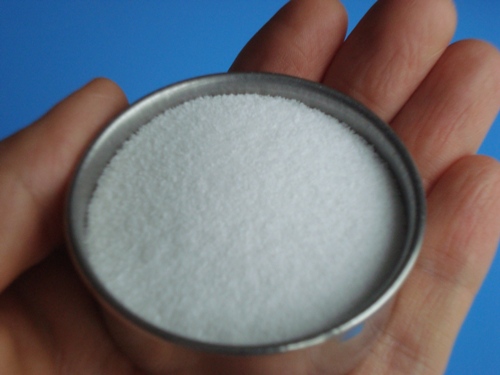
And add it to a small bowl of warm water.

Give it a gentle stir until the salt is dissolved.
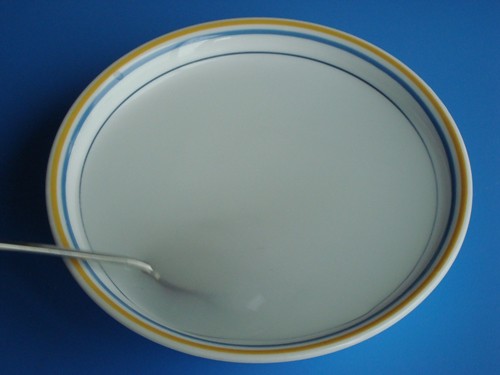
Now add the salt water to the cabbage and give the cabbage a light toss to distribute the salt water.
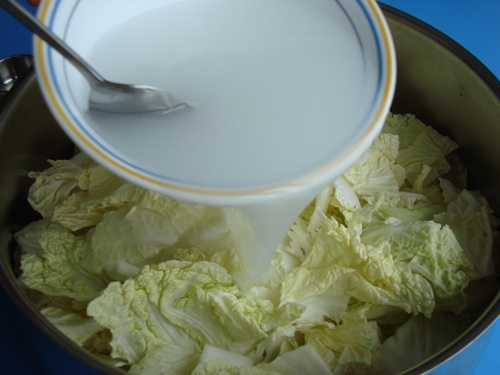
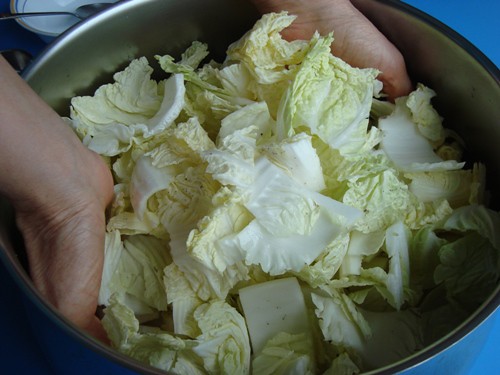
Now a bit of waiting time. The salted cabbage needs to sit at room temperature for about four hours. The salt will help draw moisture out of the cabbage, and will also act as a natural preservative.
Here's what the cabbage should look like after about four hours:
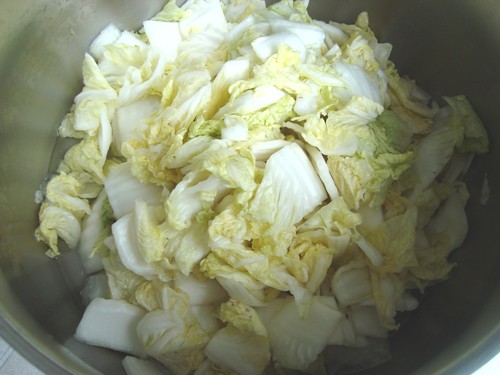
If you look closely, you'll see a small pool of salt brine at the bottom of the bowl.
Now grease up your elbows and wash and strain the cabbage two or three times. You want to rinse off the salt water and return the cabbage to a large bowl.
Congratulations - this is the base for your kim chi.
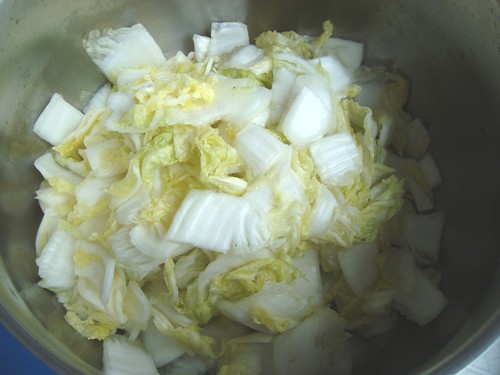
Measure out a quarter cup of ko choo kah rhoo, also known as fine red chili flakes/powder. If you don't have easy access to a local Korean grocery store, you can order ko choo kah rhoo from the following site:
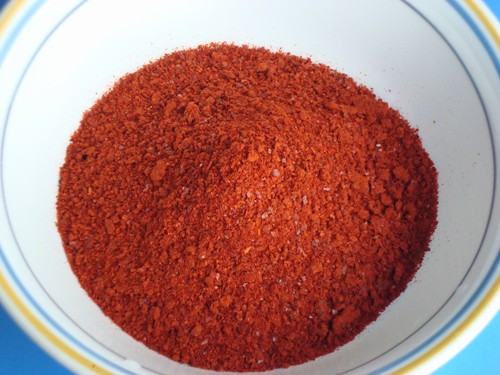
Add a quarter cup of warm water and mix with a spoon until the chili powder/flakes turn into a bit of a paste.
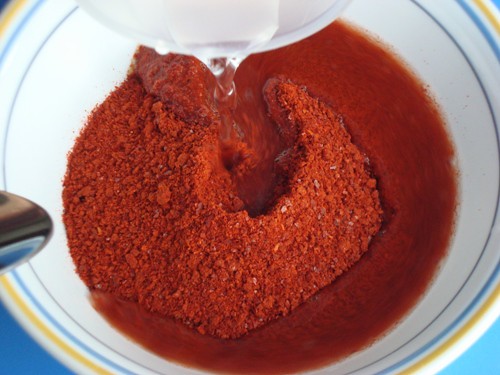
Transfer the red pepper paste to the cabbage.
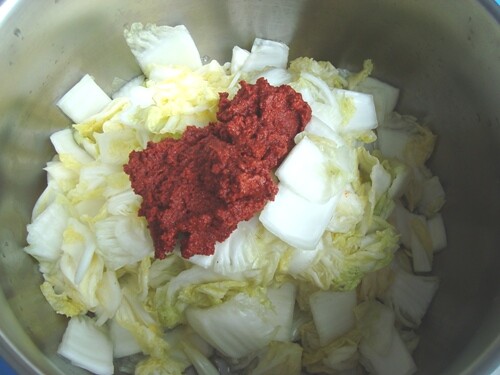
Plus a tablespoon of minced garlic.

And a tablespoon of finely chopped/minced ginger.
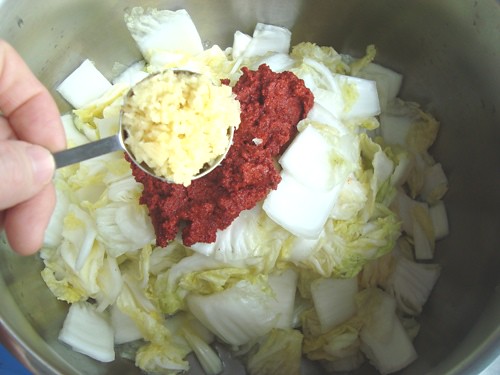
Three to four green onions, sliced.
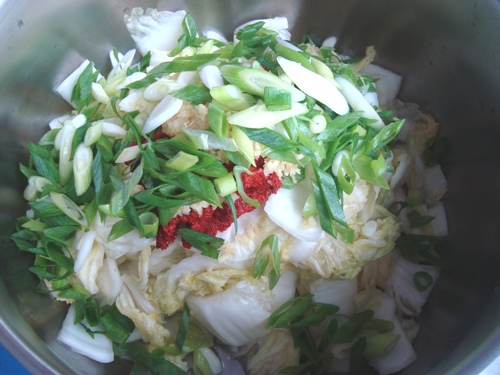
Two tablespoons of anchovy sauce or fish sauce. If you prefer a vegetarian version, you can skip this step.
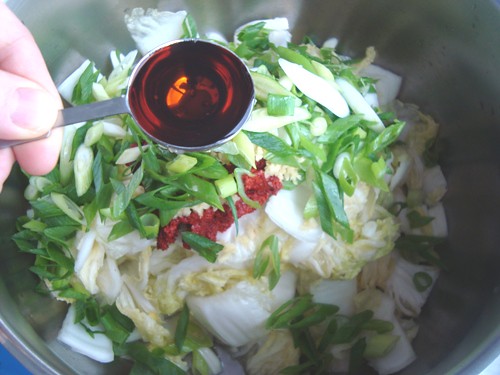
And now for the secret ingredient that sets this kim chi apart from most commercially prepared varieties: a concoction of half a ripe apple, half a ripe pear, and half a yellow onion, all blended up with one cup of water.
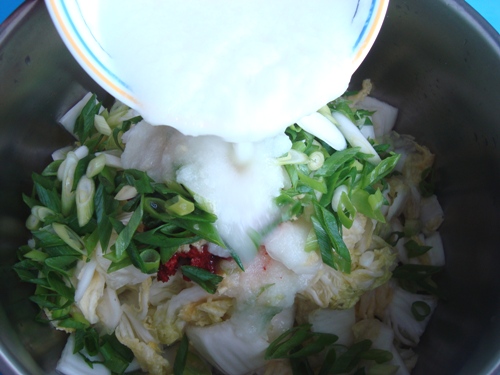
This apple/pear/onion blend adds a hint of natural sweetness to the kim chi - most commercial varieties simply add a cup of sugar.
Now put on a pair of gloves so that you can get right in there and give everything a solid toss and rubdown. Gloves are necessary, as the red chili flakes/powder will make your bare hands burn.

And voila, you have homemade kim chi that should please even the fussiest of Korean food critics.

You want to bottle the kim chi up in glass bottles, cap them, and put them away in your refrigerator for 3 weeks to ferment slowly.
One word of warning: don't fill the jars right up to their tops, as the contents will expand a bit as the kim chi ferments, and filling the jars to their rims will likely result in leakage.
Here's a look from up top:
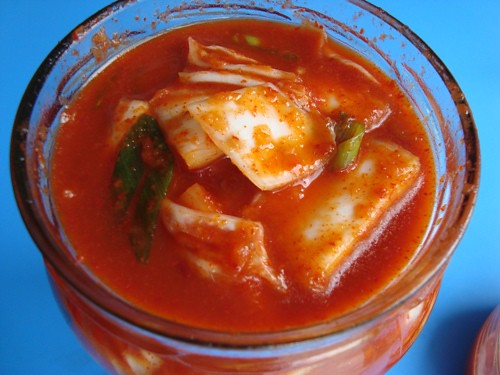
And from the front in all its glory:
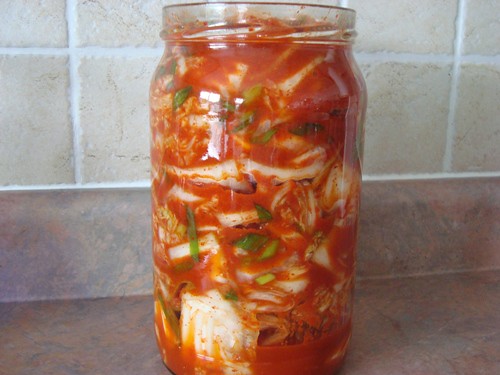
After three weeks of slow fermentation in the refrigerator, take out portions as needed. The kim chi will continue to ferment while refrigerated, and will keep for another few weeks, though the longer it ferments, the more sour it will get.
Traditionally, Koreans would put freshly made kim chi into underground jars, where kim chi would slowly ferment through late fall and winter, and portions were taken out as needed.
Click here for a printer-friendly version of this recipe (no pictures):
Once you master the art of making your own healthy kim chi, you can enjoy it as a side dish to just about any main dish, and you can make it a component of dishes like Korean pancakes (bin dae duk) and a number of different Korean stews.
If you enjoy cabbage kim chi and you haven't had a look at our recipe for cucumber kim chi, have a peek here:
Addendum on June 12, 2010 - Here's a look at some Bok Choy kim chi that we made the other day using this recipe - we used clean Bok Choy leaves in place of cabbage:
Join more than 80,000 readers worldwide who receive Dr. Ben Kim's free newsletter
Receive simple suggestions to measurably improve your health and mobility, plus alerts on specials and giveaways at our catalogue
Please Rate This
Highest Rated | Related Posts | ||







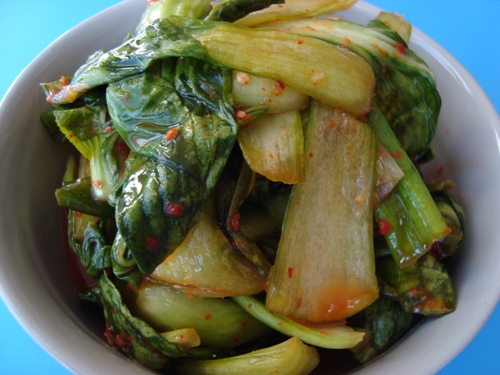




Comments
Kim chi
My step-grandmother is Korean and I have tried over the years to learn how to make different Korean dishes. One word of advice about the Kim chi. When putting it in the jar, it is necessary to push it down and really pack it in. The first time I made it, I just losely tossed it in the jar and it just doesn't ferment like it should. Also, I found that it is better to put the cabbage in a crock with the salt water in order to speed up the wilting process. Do not use plastic. I put my cabbage in a plastic bowl and 24 hours later it was still not wilted! Thanks for your great recipes!
Thanks
Your additional comments are helpful. :)
kimchi!
so delish!
i tweaked the recipe by using 1/3 cup of the red pepper and adding one small purple onion (shallot?) and i used 1 whole apple and 1 whole pear and omit the water that has to come with the pureed fruits....i pureed the apple, pear, ginger, shallot, garlic all at the same time.....my my my....
the result was so unbelievably yummy! ;)
Fabulous Secret Tip
TYVM for this tip, it is invaluable and left out of the original article.
"When putting it in the jar,
"When putting it in the jar, it is necessary to push it down and really pack it in."
- thanks for that tip! :)
This is now part of my new recipe
Tysm for this tip, I now have it saved to my new recipe, very invaluable information.
Kim Chi
My friends and I have been desperately looking for a kim chi recipe, and this one looks like a winner. We visited Korea a couple of weeks ago and we were captivated by the taste of kim chi and Korean food in general. Thank you for this...
Kim Chi recipe is very good!!
Thanks for the recipe, it is very tasty. At first I thought it was way too hot, but I'm getting accustomed to it. We have an Asian Market in my area, but I could not find the exact ko choo kah rhoo, but I asked a fellow shopper. She said that that was Korean and they were real fussy about that stuff, and that this was a Chinese Market. :)
I did get crushed red pepper flakes, it looked the same. And it's HOT!
I do have a question about the recipe though. Are there a lot of healthy
probiotics in the Kim Chi, and can one add cultures to make it more potent?
Regards,
-Peter
Hi I have some gochujang
Hi I have some gochujang paste which must be pretty much the same as the red pepper paste right? just with added stuff. And I need to use it up so I was wondering how much I should be using if Im just going straight with gochujang paste : )
no, actually not
I live in South Korea and gochujang paste dosen't actually get anytwhere to pepper paste. If you use gochujang paste, then you'll probably get no where to the orginial gimchi taste. That's why no one uses gochujang paste for making gimchi here.
Gochujang. Hot pepper paste
Hello , Nicolette . If I use the Gochujang hot pepper paste for kimchi , would it taste weird or it doesn't work well ? Also , can it still be eaten ? Advise thanks !
Gochujang hot pepper paste in quick almost-kimchi
When I read Dr. Kim's recipe, I needed kimchi fast (already cooking the healthy Korean mung-bean pancakes - bin dae duk), so I improvised a smaller amount (one meal for two hungry adults). Wilted celery in place of cabbage, one apple, one green onion, heaped teaspoon of gochujang paste (cuz that's what I had at home and no time to run to the local Korean market before dinner time), one tsp fish sauce. Chopped fruit and veg well and mashed all together. Not authentic kim chi, but surprisingly yummy and went very well with the bin dae duk. Now I'll try the "authentic version" - but may stick to the gochujang paste (around the same amount as the suggested powder plus water together), because I love its taste.
How to Make Kimchi
I posted in another post my love of really good, legitimate kimchi. I lived in Taegu, Chungmu, Chonju, and Pusan (Gupo) for about two years and really came to appreciate kimchi. My favorite is oe kimchi or cucumber kimchi but this type of kimchi, if made well, is great on white rice or even just by itself. I never knew how it was made step by step, which you provided with the excellent instructions. As I thought kimchi had to be put into the ground for optimal fermentation, as I saw it done a lot in south Korea, of course, I thought I couldn't make it here. I can see you can now.
Thanks!
GR
Kimchi Fermentation
GR - it was put into the ground to provide an anaerobic environment - no air - and the CO2 was offgased through the porous nature of the crock it was put into - but that setup is a bit difficult here in the city - so the Pickl-it Jar system provides the same safe ideal environment to properly ferment kimchi - or kraut or pickles...etc...
I have more info on my webpage if you are interested in learning more let me know if you want to order one - I can help you figure out which jar/jars would work best for your home - and get you a great deal as well.
Happy fermenting!
Lisa
Fermentation
If you are concerned about the outgassing during fermentations, try using a pre-drilled stopper in the mouth of your jar with a vapor lock (normally used in brewing beer). This will give you the ability to outgas as well as preserve the gimchi from outside yeasts and molds.
Love Your Recipes
Hello Dr Kim
Thanks for sharing and putting up the pics step by step. I love them and will go out to buy the ingredients to fix a "kim Chee" for my friends for a "Korean/Japanese meal this weekend.Think they are going to love it !
Merry Christmas
Cheryl
This Kimchi Recipe is amazing
Dr Kim,
I admit that I didnt like Kimchi cause I didnt know what was in it. After reading your recipe,I went to my Korean market in the Bronx, Got me some Napa Cabbage and some korean red pepper flakes. I followed your recipe and tara !!! amazing piece of culinary art. I love it. Thank you
My first time
This was so useful in my first time making kimchi. I have been buying kimchi from stores in those glass jars forever. I decided to try and make my own, as it is probably healthier and I would know what goes in it. It is right now fermenting in the cabinets as I have just finished making it (literally). It was an excited experience staying up all night to wait for it to wilt! Hopefully the work will pay off, but I can't wait to have my first taste!
Yummy Kimchi
I love this recipe! I had a lot of Kabu (Japanese turnips)in the garden that I did not know what to do with! I made Kimchi with them and the leaves. I also did not have any ko choo kah rhoo so I used the kind of red chili flakes that are for pizza sprinkles! It turned out a little different than regular Kimchi, because the flakes aren't ground as fine as ko choo kah rhoo, but it is going to turn out different anyway, right?! My daughter made some Kimchi soup with it and some other Kimchi that I had in the fridge from the Korean market. Yummy! I am taking a trip next week to San Diego so I will pick up some ko choo kah rhoo from the Korean market, Zion and make some more.
Thank you Dr. Kim!
This is going in my recipe
This is going in my recipe file and the cucumber kim chi too. A year ago, if you mentioned fermented and food in the same sentence, I would have never tried it. Now I eat tempeh, kim chi and kombucha.
Asian cuisine is quickly becoming my favorite!
I've been searching for an
I've been searching for an easier recipe for kim chi. I finally found one today and I will definitely make this. Thank you.
Ken
Kim Chi
Your recipe was delicious! W double it and made 2 jars. It was just the right amount of spiciness and heat. It went fast in our house, less than 1 week!
I have made this twice and it
I have made this twice and it is really good. I let it ferment for 3 days though because I like it sour and this speeds up the fermentation process so I can enjoy it sooner. I was wondering if you had any recipes for radish kimchi or yeolmu kimchi. thanks for the great recipes!
Kimchi
My friend's mother used to make it all the time but instead of letting sit out for 24 hours she buried the jars in the backyard! I am not kidding she said that it allows the cabbage to drink up the juice.
Fish Sauce
I mixed up a batch of this minus the fish sauce and am happily waiting for it to ferment.
I'm vegan and I'd like to know for future kimchi-making would it be better to leave the fish sauce out or should I actually use a vegetarian fish sauce instead?
we've been using bragg's
we've been using bragg's aminos in place of fish sauce, you could use soy sauce or nothing as well
Vegan "fish sauce"
I am not vegan but I am alergic to fish and have been using a vegan "fish sauce" that I found at my local asian market. My friends who eat fish say that it is very similar to the real stuff. Nice and funky!
GREAT recipe--fast and easy too
I love this recipe! I've made this with mixtures of:
cabbage/carrots/scallions
or
daikon radish/chives/carrots
and I use a couple of chopped up dates for the sugar instead of the apples and pears mixture. You can pretty much use anything that has some sweetness to feed the bacteria--any dried fruit, honey etc.
The dates work really well and you can't really tasted them in the mixture but there is a certain earthyness to the kim chee that I like a lot.
I like it a bit more fermented so it has less sugar and more good bacteria, so I leave it out a few days in the summer and longer in the cooler months.
DO NOT eat too much of this delicious stuff at once! ;)
finally
I've made a few different fermented cabbage recipes that I composted. They were so salty that I could not eat them. I am so happy to find your recipe that uses salt for the right reason and then rinses it off. I like the fruit and onion idea, too. This sounds delicious. I became acquainted with kim chi about 20 years ago but addicted to it in Hawaii. There are several wonderful Korean restaurants that make many varieties there. I have been trying to make it at home with zero success. Now I think I'll have success!
Hello. Fellow big Dr.Ben's
Hello. Fellow big Dr.Ben's kimchi recipe fan here! Using honey in pickles is not recommended just in case of botulism. Happy safe pickling! Cheers!
Kim Chi
Is it possible to miss out the chilli or is the chilli part of the fermentation process. Only to be honest I don't care for chilli. If I can miss it out, do you have any other ideas on which herbs and spices I could replace it with. Thank you in advance.
Kimchi fermenting jars...
For those interested in making their own kimchi, I am a potter making traditional Korean Onggi (fermenting jars) available for purchase. I had the opportunity to study for a year with a 7th generation family of Onggi potters in Korea. Traditional jars make better kimchi!
Adam Field
www.adamfieldpottery.com
I made some kimchi in an
I made some kimchi in an olive jar with the brine, then drained and washed it and threw some garlic and cayenne in there. Sat for 2 days and turned out great.
Fermentation
When I make kimchi, I wait two weeks before beginning to eat it so the fermentation can develop added nutrients (vitamins) and probiotics (lactic acid bacteria). Also, it takes about 9 days for the lactic acid bacteria to break down the pesticides used on the Napa cabbage (unless you are fortunate enough to have Organic Napa cabbage available to you – we are not).
I let the bulk of the kimchi ferment for 5 weeks at 70F, and then I move it to a cooler area (below 60F for storage). By 5 weeks, the taste changes becoming more complex and absolutely delicious. With the bulk being Napa cabbage (85%), I also add turnips, carrots, apples, cucumber, baby bok choy, an assortment of peppers (Jalapeno, Cubanelle, Poblano), garlic, ginger, scallions, onions, Korean red pepper flakes, rice flour, and a touch of horseradish (helps maintain crispiness).
I only like it mildly hot, so instead of 2 cups of Korean red pepper flakes, I only use 3 Tablespoons for the entire batch (about 8 heads of Napa cabbage. For convenience, I let the kimchi ferment in loosely covered (plastic caps) 1-quart Mason jars. I check it every few days to ensure the veggies are covered with ~1” brine (1 Tablespoon non-iodized salt per 1-quart water).
breaking down pesticides?
Just wondering what you mean by 'breaking down the pesticides' and how you know this is happening / has happened? Thanks in advance for your reply.
nutrients
Thank you! Excellent idea! I am lactose intolerant and need all help I can get...I can take yogurt, but kemchi is yummier, thoug addicttive,,I even have it for breakfast! ????
hotness
I do not like real spicy foods either. I wonder what is the least amount of the red pepper you can put in? A tiny jar of this at my store costs a lot and I'd much rather be able to make it myself. But if the red pepper is a necessary ingredient I don't want to use too little of it and spoil the whole batch.
hi Adam, loved your video,
hi Adam, loved your video, you make it looks easy! agree with you entirely on using a traditional jar.
Ferment jars
I would like to purchase a Kim Chee ferment vessel from you.
I would also like to get back to my wheel throwing making my own ferment vessels ( I was a potter in the 70s )
That is amazing, Adam!
That is amazing, Adam!
Kimchi
I looked at a lot of sites to make kimchi and this by far the best. I've made it 3 times and now making a 4th. I didn't use the fruit so probably not as healthy, but I was looking for authentic not healthy. I used 1-T of sugar instead. It is fantastic!! So easy to follow with the pictures. The 2nd time I added shredded carrots and radish that really made it great. Cut them yourself or buy from the Asian market. With this 2nd batch after several weeks I made Kimchi Soup. If you've never had it you should try. It's wonderful. Thanks Dr.Ben for the great site.
KimChi Juice
How is it your kimchi is full of water in the jar...? Didn't you removed the brine water after soaking?
Did you throw away the brine water or you put it back into the jar to soak the cabbage?
I had this question as well.
I had this question as well. There appears to be a lot of liquid in the jars...does that just develop during the fermentation process or should I be adding something else? I love Kim Chi and want to make my own...but want to get it right because I'd be so disappointed if I messed it up!
Thanks!
Throw out the brine & rinse well.... :-)
I too was wondering this… But I took a chance and tried it without the brine water because there wasn't any instructions to add it back in… And it turned out wonderful!!!
Throw out the brine water... Rinse well... It'll be great.
**the other thing that I didn't see spelled out was if the apple needed to be peeled... Since the picture of the sugar alternative was white liquid, I peeled the apple.... Again, it turned out great!
I'm making it again right now! Yum!!!
Sodium per serving
Dr. Kim, how much sodium per serving would this beautiful Kimchi contain? Fermented foods are so vital to health, but those in a sodium restricted diet have to be cautious
Hi Liza,
Hi Liza,
It's difficult to say for sure, as a good amount of the salt used for the brine does get discarded.
My estimate would be about 120 to 150 mg of sodium per two heaping tablespoons of kim chi, which is a generous serving as a side to any meal.
I hope this is helpful!
Ben Kim
I have been making this
I have been making this recipe for a few years now. I use whole fruit for the sweetener, which doesn't noticeably alter the taste. I like to vary the main ingredients every time I make it. Adding carrots, or cauliflower, or bok choy. One double batch lasted over a year in the fridge! Tasted awesome to the last bite! I just had to say thank you for sharing an outstanding and delicious recipe! I always keep at least one giant jar in the fridge because this has become a staple in our diet. Thanks again!
Trying not to run to the
Trying not to run to the store. Do you think green head cabbage and kosher salt would be ok to use?
tumeric
Anyone ever try adding turmeric root with the ginger? Not traditional but seems like it might add a health boost.
Why Would You Do That?
Turmeric has a very strong flavor and is the wrong color entirely to use in Kimchi. Why in the world would you want to destroy traditional dish of a historically rich culture like that? My goodness.
Been using this kimchi recipe
Been using this kimchi recipe exclusively for years now and I will never use another. Great vegan recipe that is healthy and smells soo good after fermenting. Thank you!!
Ok - Daikon pickles were
Ok - Daikon pickles were awesome first try - have some more I need to make for friends.
KimChi - not so good first try - too much liquid in the end and it was hot!!! I did cut the pepper paste in half. But still a work in process. I first had Kimchi in Korea in the early 70s and it was the old version - 6 months in the ground in a churn and it burned me big time.
Cold and Flu - I kinda like it but my wife choked on the heat:-) Will have to adjust a batch for her in the future.
I'm going to try this recipe
I'm going to try this recipe but way less red chile flakes/powder. Really excellent presentation of the graphics and instructions!
This is really good!
A friend forwarded me this recipe for my first attempt at making kim chi, and it was a success! It made three quart jars full, so I experimented with fermentation. I put one jar in the dark in a cupboard for 3 days with an ambient temperature of around 22C. That one got really sour with a slight vinegary finish without much other flavour - not great at all. I put the other two jars in the fridge. I ate through one of them slowly over 2 weeks to get a feel for slow fridge fermentation, but the taste just wasn't that great. I thought my kim chi experiment had failed, and it was finally when I opened the 3rd jar after 3 weeks in the fridge that I got all the magic: crunchy, spicy, a bit of salty, and a hint of sweetness all wrapped in a punchy sourness with a clean finish. This recipe will be a staple in my fridge from now on.